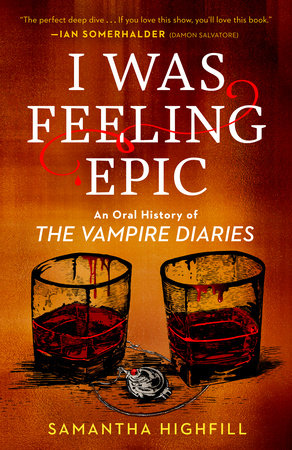Chapter 1
Twilight for TV
Hey kid, get ready for the ride of your life."
Sitting on the Vancouver set of The Vampire Diaries pilot, Ian Somerhalder had no idea how right he was when he spoke those words to his costar Zach Roerig. They were just starting work on the first of what would become 171 episodes of television that would help mold a network, launch numerous careers, and create a fandom more rabid than Stefan on a Ripper binge.
The idea started on a beach, of all places. Leslie Morgenstein, who'd go on to become the president of Alloy Entertainment, wrote the pitch for the book series when he was still an assistant. His boss, Elise Howard, had asked him to come up with a YA vampire series as he headed off on vacation. "My older sister was reading Interview with the Vampire in a funny vampire voice aloud on the beach, and I was like, 'What's the YA version of that?' " Morgenstein says. "I came back from vacation and I wrote up a pitch, and in fact many of the characters are named after friends of mine from high school. Damon Salvatore is named after my buddy Damian Salvatore, who's a chef back in DC, where I grew up."
With the concept in place, L. J. Smith was tapped as the author of the Vampire Diaries book series. But despite Smith's first book being published in 1991, it wasn't until a certain early-2000s vampire craze came about that Alloy, which owned the books, realized that they'd been sitting on the perfect project for an adaptation. And yet, some worried that the vampire trend was on its last leg. With Twilight and True Blood already glamouring audiences, was there room left for another show about sexy bloodsuckers? "I thought we would be the nail in the coffin," Vampire Diaries cocreator Kevin Williamson admits. "We kept talking about how we would kill the vampire craze."
But instead, in the fall of 2009, audiences quickly fell for the story of Elena Gilbert (Nina Dobrev), the high schooler who'd recently lost her parents, and Stefan Salvatore (Paul Wesley), the mysterious vampire who brought her back to life. And then, of course, there's Elena's angsty little brother, Jeremy (Steven R. McQueen); her witchy best friend, Bonnie Bennett (Kat Graham); her all-American quarterback ex-boyfriend, Matt Donovan (Zach Roerig); head cheerleader (and not-so-typical mean girl) Caroline Forbes (Candice King, née Accola); angry jock Tyler Lockwood (Michael Trevino); Stefan's big, bad older brother, Damon (Ian Somerhalder); and many more. The world of Mystic Falls, Virginia, was rich in possibility, the cast was electric, and it didn't hurt that they were all supernaturally attractive.
"You had an unbelievably engaging cast across the board with Paul, Nina, Ian, and the rest," says Mark Pedowitz, CW president from 2011 to 2022. "It was a high school series, so there was a coming-of-age relatability. It was two brothers who loved each other and hated each other, which seems to have been a popular theme at the CW, and it was a love triangle. Who doesn't like a brooding vampire, and who doesn't like a bad-boy vampire?" (Elena, and audiences, would come to love them both.)
After its premiere on September 10, 2009, The Vampire Diaries delivered the highest-rated pilot in the CW's short history. (The network had been created in September 2006.)
"Vampire Diaries was a success right off the bat, but I can tell you that it wouldn't have mattered," says Dawn Ostroff, CW president from 2006 to 2011. "We believed in it so strongly that it was going to stay on the air no matter what."
And stay on it did, for eight seasons of romance, shocking twists, and so, so many doppelgängers. By the end of its impressive run, it had outlived all five Twilight films and all seven seasons of True Blood, and along the way, it had managed to launch an entire universe with not one but two successful spin-offs in The Originals and Legacies.
"The reason why Vampire Diaries worked is because [cocreators] Kevin [Williamson] and Julie [Plec] started from a foundation of: Here's this series of books; there's a really cool ensemble of characters-some are human, some are vampires, some are witches-and we're going to treat all of them like multidimensional realistic characters," series writer (and The Originals showrunner) Michael Narducci says. "When you have realistic characters, you don't know how they're going to behave, so the show is unexpected. There aren't good guys and bad guys. On Vampire Diaries, you don't know what these characters are going to do, let alone who is going to win."
Throughout its long journey, the series never stopped surprising audiences, whether it was by killing a beloved character, creating an unexpected new romantic pairing-sorry, a ship-or bringing in a villain who nobody saw coming. Thanks to a passionately dedicated audience, the show-unlike its characters-never had to fear for its life. It even survived star Nina Dobrev's departure after season 6.
In the end, the show decided when it wanted to say goodbye, and it aired its final episode on March 10, 2017, leaving behind an epic legacy.
"It was the glue that solidified the CW," Ostroff says.
Which is ironic, considering the CW originally didn't want anything to do with vampires.
Jennifer Breslow (The CW vice president of drama development): We always did a retreat at the beginning of every [development] season with the whole team, and we'd set goals for ourselves. One of the things that everybody said at the time was "What about a vampire concept?" And it was very, very clear coming away from that retreat that there was no room in the world for another vampire show. True Blood already existed; Twilight had already come out.
But Alloy Entertainment, which was already in business with the CW with Gossip Girl, had seen success in rereleasing the Vampire Diaries books (originally published in the early nineties) thanks to the recent interest in the genre.
Leslie Morgenstein (Alloy Entertainment president; executive producer): It started as a trilogy, which wound up being four books, and they did okay, but they didn’t really light the world on fire. And then when Twilight became a big hit, we went back to the publisher, HarperCollins, and said, “We’ve got to do something with these books. Let’s reissue them.” So they did, and the books really took off with new jackets.
Bob Levy (Alloy Entertainment executive vice president of television and film development and production; executive producer): The reissues blew up. This seventeen-year-old book is suddenly, for the first time, a New York Times bestseller. And that was my cue. The pitch was very simple: It was TV Twilight. But we had the magic bullet of avoiding the accusation that we were ripping off Twilight by the fact that our books came first. . . . We had a first-look deal at Warner Bros. so we went to the studio first, and then in partnership with the studio, we approached networks. And Warner Bros. passed. But that didn’t stop us. We basically went around our studio, which is quasi not kosher, but we were just so committed that TV Twilight was a no-brainer, which is when we approached the CW. So [vice president of TV development and production] Andrew [Wang] submitted the book to Jen, and I heard from Andrew that her boss, Thom Sherman, wasn’t interested.
Jennifer Breslow: Andrew had sent me the books. I literally put them on the credenza, and they sat there all season.
Leslie Morgenstein: Something came back to us via Warner Bros. the studio, that the CW doesn’t want to do Twilight for TV, and my response was, “What are they talking about? Of course you want to do Twilight for TV.” It was the biggest thing in entertainment.
Bob Levy: I called Thom and he’s like, “I don’t get what the show is.” So I went back to Andrew and Les, and we talked about it and we agreed it’s a supernatural ensemble. I called Thom back and I said, “At the beginning of the week, you have Gossip Girl and 90210, you have YA soap ensembles. At the end of the week you have Smallville and Supernatural. You have supernatural genre shows. If you put a supernatural soap ensemble YA drama in the middle of your week, all of a sudden your entire schedule makes sense.”
Jennifer Breslow: We got to the end of pitch season, and we had a couple more slots, so I thought, “Let me read it because it’s Alloy and we’d obviously had success from Gossip Girl.” I read the first book that night and I was like, “Oh, there’s a huge concept in here that does feel differentiated from True Blood and from Twilight.” It was more soapy. It was sexier. True Blood was so campy that, to me, it felt like it could exist separately. And Twilight was movies.
Bob Levy: Thom called me the next day and said, "We're buying it."
But what Levy couldn't anticipate was who would write it, a collaboration that came together when Breslow headed to lunch with her friends and former coworkers Kevin Williamson and Julie Plec. Williamson was best known for creating Dawson's Creek and the Scream franchise. Plec, who'd worked with Williamson on the Scream franchise, had begun her foray into television with Kyle XY.
Kevin Williamson (cocreator): I was dealing with grief because my partner had died recently, and I was in total shutdown mode of loss and despair, and Julie and Jen had taken me to lunch to try to cheer me up. I was in the worst place I’d ever been in my life, and they were my friends who were just cheering me up. Jen was like, “You just need to work.”
Julie Plec (cocreator): I was telling them about a pitch that I had about a supernatural boarding school and how much I loved that world, and we were talking about whether there were any vampires in it. I said, “I don’t think so because as much as I love vampires, between Twilight and True Blood, I feel like vampires are over.” Jen said, “I hope not because we have a book we’ve been trying to put together for a vampire show and we can’t find writers. It’s a series called The Vampire Diaries.” Kevin said, “Oh yeah, I know that book, somebody sent it to me years ago wanting to know if I could adapt it into a movie.”
Kevin Williamson: I never read it, but a few years earlier, the book was submitted to my development executive as a potential movie, and I just went, “Oh, teen vampires-no, thank you.”
Julie Plec: Jen said, “Do you guys want to make it into a TV show?” and Kevin said, “No.” [Laughs]
Jennifer Breslow: Kevin was like, “No way.”
Kevin Williamson: I thought the vampire craze would be over because by the time you start a project and adapt it and get it to screen and get going, it’s just over.
Julie Plec: But I was young and hungry, so I was like, “I’ll do it.” I had never actually created my own TV show, so I would’ve done anything. And Kevin goes, “Oh, all right, let’s do it together.”
Kevin Williamson: I said, “I’ll do it if Julie does it; we have to do this together.” I just wasn’t sure if I wanted to do something alone at that time. Then Julie read the book overnight, and she called me up and said, “Stop reading right now.” I said, “Why?” And she said, “Because if you turn the page I’m scared you’re going to say no.”
Julie Plec: It was so much like Twilight. They were written well before Twilight, so we had that as a defense, but it just wasn’t something that he was all that excited about diving into because it felt too familiar, so we had to get over the hump of feeling like it was a retread of another person’s success. I said, “I’m not sure you’re going to like this, but I think that there’s something in here in the way that Buffy built an entire journey around a town. There’s something about this town, which at the time was called Fell’s Church, and all the characters within the town that could make it something special.” I was such a big Buffy fan, and I always loved Sunnydale and the ensemble. I love that energy of kids just trying to make it through the day. I knew the love triangle would work because of Twilight; I didn’t quite know how to do that to make it new and fresh, but there was something about this town where mystical shit is always happening that I thought was a really good platform for a show.
Kevin Williamson: Dark Shadows was one of my favorite shows growing up, and I thought if we can lean into the town and everything that’s going on in the town-because in the book I think it was so many soldiers’ blood had shed on this ground during the Civil War that it attracted the supernatural-and I thought that was really fascinating. But I also connected to Elena, who had lost her parents and was dealing with death, because grief and loss is my and Julie’s favorite subject, so I connected mainly to this young girl who needed to be brought back to life, and it just turns out that she was brought back to life by a dead guy.
Jennifer Breslow: I came back from that lunch and I said to Thom, “Hey, what do you think about Kevin and Julie writing it together?” And he goes, “All you have to do is say ‘make an offer’ if they’re in.” A week later we made an offer and we had such a short time to develop it because it was the end of development season. So they wrote an outline for it in a couple of weeks. We noted the outline, we sent ‘em off to script, and it all happened very, very, very quickly. We were hustling to get it done.
Kevin Williamson: I thought, “What is this really about?” It’s this young girl who is dealing with death. I went, “Okay check that box.” It’s about how this dead man comes along and brings her back to life. I went “Okay, wouldn’t that be lovely? That’s certainly what I need right now.” And so I used that metaphor and played against the allegory, and Julie and I sat down at a kitchen table and we wrote it and we just cried over it. We tried to find that part of it that was really about Elena trying to learn how to live again. And it worked. It really worked. And in a weird way, the whole show was my Stefan.
Copyright © 2025 by Samantha Highfill. All rights reserved. No part of this excerpt may be reproduced or reprinted without permission in writing from the publisher.







